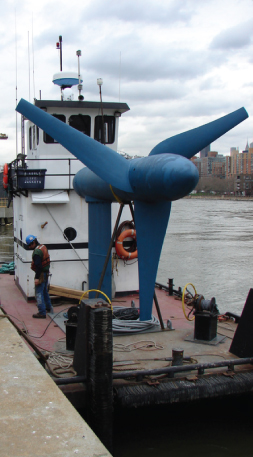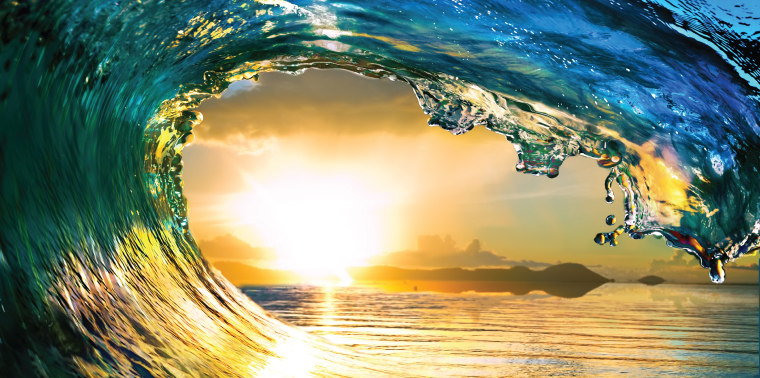March 10, 2014 — Long before humans got hooked on fossil fuels, we learned how to harness the power of water to do work. Rivers ran mills that ground flour, sawed logs or spun looms that transformed fibers into textiles. Later generations realized that moving water could also be used to turn electricity-generating turbines. But dams erected with electrical turbines blocked waterways, compromising riverine ecosystems to deliver power to growing cities.
Devices now under development in the United Kingdom, the United States and elsewhere generate electricity by tapping the movement of ocean waves and tides or the differences in temperature of water between an ocean’s surface and its depths. The sector is ripe with promise, but to reach its potential, the engineers, entrepreneurs and policy-makers working to wring carbon-free electricity from moving water and thermal gradients must overcome formidable regulatory and financial barriers.
High Potential
Government and academic estimates project that marine renewable energy could supply a significant share of the electricity used in coastal areasProponents of marine hydrokinetics or ocean thermal energy conversion often note that the technologies deliver electricity that is both dependable and in the right place. After all, waves and tides can be predicted. And humans tend to cluster near water: Nearly 40 percent of Americans live in counties directly on a shoreline, and more than half the world’s population lives within 125 miles of a coast.
Government and academic estimates project that marine renewable energy could supply a significant share of the electricity used in coastal areas. Assessments commissioned by the U.S. Department of Energy found that “the maximum of theoretical electric generation” that could be produced from waves, tidal and riverine currents, and ocean thermal gradients in U.S. waters is 2,116 terawatt-hours annually, a little over half of the electricity consumed in the country each year. One TWh of electricity can power 85,000 homes. According to the California Energy Commission, the exploitable ocean wave energy generation potential of the state is about 7,400 megawatts, equivalent to 17 percent of the peak load managed by the California grid operator in recent years.
Research published by engineers from Oxford University and Edinburgh University in January 2014 found that tidal turbines placed in the Pentland Firth, a narrow stretch of water separating the north coast of mainland Scotland from the Orkney Islands, could generate 43 percent of Scotland’s electricity. According to RenewableUK, a trade association, the wave energy potential in U.K. and Irish waters is 840 TWh annually, equivalent to half the total European wave energy resource and nearly two-and-one-half times the U.K.’s current annual electricity demand.
Fast-Developing Industry
At an ocean energy panel convened at the University of California, Berkeley, School of Law in September 2012, Bill Toman, then a project manager with Science Applications International Corporation’s Ocean and Marine Systems division, noted the flourishing of innovation in the sector. Toman, now a principal with Pacific Marine Renewables, estimated that some 80 different marine renewable energy technologies were under development around the world, with about a dozen at a mature stage.
“It’s advancing at a faster rate than wind was 30 years ago,” says Paul Jacobson, ocean energy leader with the Electric Power Research Institute. Jacobson says he doesn’t believe the marine renewables industry will need 30 years to reach where the wind sector is today because design engineering has advanced so much in recent years.

In 2012 Verdant Power installed hefty turbines below the surface of New York City’s East River to turn tidal energy into electrical power. Photo courtesy of Verdant Power, Inc.
A handful of developers in the U.K., U.S. and China have secured approval for or signed deals to build commercial-scale projects. In September 2013 the Scottish government gave the go ahead for construction of the first phase of the 398 MW MeyGen tidal energy project. The first six turbines are scheduled to be installed in Scotland’s Pentland Firth in 2015.
In January 2012, Verdant Power received the first commercial license for a tidal energy project in the U.S. The Federal Energy Regulatory Commission authorized Verdant to install up to 30 turbines with a combined capacity of just over 1 MW in New York City’s East River to capture the energy of water moving with the tides. During its demonstration phase, the project delivered 70 megawatt-hours of electricity to two customers in New York City.
Dean Corren, director of marine current technology with Verdant, says the company plans to install its next-generation commercial turbine, Gen5, at the site. Financial support from the DOE, he says, will enable testing of key components — steel, gearbox and blades — over the next year to determine the reliability of the new turbines under water. The first Gen5 turbines should be in the East River in 2015.
In October 2013, Lockheed Martin signed a contract to build the world’s largest ocean thermal electric power plant, a 10 MW facility likely to be constructed in southern China. Lockheed plans to build a closed-loop system that uses the heat from warm surface waters to convert ammonia, which has a low boiling point, to a gas used to power a steam turbine. Cold water deep below the surface is then used to convert the steam back to liquid.
Dan Heller, vice president of new ventures for Lockheed Mission Systems and Training, told Reuters at the time that Lockheed planned to begin work on a 100 MW design during the course of the project and expected to be able to start marketing the 100 MW and 10 MW versions globally in about five years.
Rough Waters
Even as technology advances, industry and government experts agree that significant hurdles must be overcome if electricity generated by marine renewable energy technologies is to compete on price anytime soon with power from fossil fuels or from more mature sources of renewable energy such as solar, wind and geothermal. According to Max Carcas, external liaison for the European Marine Energy Centre, marine energy costs $0.42 to $0.50 per kilowatt-hour today, more than two times the average price of electricity from offshore wind farms.
Regulatory challenges and technical limitations have made building utility-scale wave, tidal and ocean thermal projects difficult. In August 2012, Ocean Power Technologies received the first Federal Energy Regulatory Commission license for a wave power plant in the U.S., for a 1.5 MW array of devices to be located off the Reedsport, Ore., coast. A year later, The Oregonian reported that regulatory and technical hurdles had stalled the project and that “OPT now makes vague promises to test their first buoy in Oregon waters no later than 2016.”
Project developers, many of them start-ups, find it difficult to stay afloat financially as they work to obtain the required permits.
Delays have not been limited to the U.S. The Wave Hub, a marine renewable energy test platform located on the seabed 10 miles off the Cornwall, U.K., coast and connected to the onshore grid via a subsea cable, was completed in 2010 but has yet to be used. OceanEnergy, an Irish wave energy firm, had planned to deploy its OE Buoy at the site by the end of 2012. In December 2013, Wave Hub announced the wave energy company Seatricity plans to develop a 10 MW array at the site over the next two years.
“The past five years have been pretty brutal for developers in trying to site ocean wave, tidal and hybrid wind-wave projects,” Pacific Marine Renewables’ Toman said at the 2012 Berkeley gathering. Project developers, many of them start-ups, find it difficult to stay afloat financially as they work to obtain the required permits.
“A lot of the engineer folks who wanted to put something in the water, once they got a glimpse of the regulatory framework, their eyes went big and they decided, ‘OK, I’m going to need a lot more money, and I’m going to need to talk to some more consultants who know something about this,’” Laura Engeman, a project manager with the California Ocean Protection Council, told the same panel.
The challenge for regulators, Engeman added, is “balancing opportunities for testing with providing the necessary environmental precautions. Industry developers are financially limited. It’s often a big hurdle for them to develop the kind of baseline information that most permitting agencies require.”
“Because these are new technologies that are being placed in environments where this sort of thing hasn’t been done before, there is a lot of environmental uncertainty,” says EPRI’s Jacobson. “The industry is being held to a very high standard.” A report prepared for the California Ocean Protection Council and California Energy Commission, published in November 2008, found that “few major impacts of wave energy conversion installations on marine birds and mammals are anticipated,” but that baseline data collected before devices are placed in the water “will be critical for evaluating post-installation effects.” The authors concluded that “while significant technological and economic issues remain, ecological issues, at this stage, appear manageable.”
One issue completely dominates this scene and limits the rate of growth, and that is capital availability.” — Dean Corren, Verdant
Still, things look better on the horizon. To help developers navigate the regulatory process, the California Ocean Protection Council published permitting guidance for ocean renewable energy projects in December 2011. And in August 2013, U.S. senators Ron Wyden, D-Ore., and Lisa Murkowski, R-Alaska, introduced the Marine and Hydrokinetic Renewable Energy Act of 2013, which would promote the development of and streamline permitting for marine renewable technologies. On January 20, 2014, the European Commission released a two-step Blue Energy Action Plan under which the EU will first convene stakeholders to identify and propose solutions to challenges facing the marine renewables industry and then develop a strategic road map by 2016 to guide the sector toward commercialization.
Show Us the Money
Then there’s financing. “It has to be understood that one issue completely dominates this scene and limits the rate of growth, and that is capital availability,” says Verdant Power’s Corren. “For emerging energy, venture capital does not exist anymore.”
“A lot of the wave stuff is just too early stage for even venture capital,” Toman told his Berkeley audience. “It’s been estimated that it costs about $100 million to go from a cocktail napkin drawing to a commercial wave device. That’s a frightful amount of capital to ask your garage inventor to come up with.”

Ocean Power Technologies’ PowerBuoy makes electricity as it bobs in the choppy seas off the coast of Scotland. Photo courtesy of Ocean Power Technologies, Inc.
Where marine energy is setting roots, it’s often thanks to government intervention.
“That’s why Europe is eating our lunch,” Corren says. “Our government now has the philosophy — at least half of it has the philosophy — that government shouldn’t be doing anything.”
Proponents acknowledge the importance of government assistance provided to the industry — they just wish there were more of it. “Since the election of President Obama, the Department of Energy has reconstituted its hydropower program and also has made a commitment to marine renewable energy, both tidal and waves,” says Corren, “but it’s still far beyond where it really ought to be if we want to be a major player in the world industry.”
EPRI’s Jacobson notes that the DOE has sponsored marine renewable energy resource and environmental assessments (EPRI led the wave and riverine resource assessments), technology development of components, and project development.
“DOE contract support has been incredibly helpful,” Corren says. “The state of New York has been unbelievably helpful since the ’80s.” The DOE recognized it needed to boost the cost share of its grants to match what other countries offered, he says. Before, contracts came with 50/50 cost share; now, contracts can come with up to an 80/20 cost share. In August 2013, DOE awarded $16 million to advance 17 projects that capture energy from the waves, tides and currents.
Bright Future
Industry backers agree that marine renewables have a bright future even if, in the near term, they may advance more rapidly outside the U.S. Corren says this will likely mean that most U.S.-based companies will move overseas. “Either Europe, particularly the U.K. and Scotland, or South Korea,” he says, adding that Verdant already has a company in England. “We’ve been in conversations with China. These are countries with important resources and important commitments to investing in the technology to make it happen,” he says.
At the Berkeley talk Toman agreed, saying, “Wave and tidal is going like gangbusters in Europe, especially the U.K. and Scotland. I see that migrating here to the U.S. They view the California market as kind of the Holy Grail. We may be in a slow period at the moment, but I see the European efforts reaching out to colonize us.”
Experts are convinced that marine renewables will become more competitive over time as the technology matures.Prototypes of nearly a dozen marine energy devices are operating at sites run by the European Marine Energy Centre, a grid-connected test center in Scotland’s Orkney Islands established in 2003. More wave and tidal energy devices have been tested at the $59-million facility — staked with funding from the Scottish and U.K. governments and the EU, but self-supporting since 2011 — than any other site in the world. According to the European Commission, some 2 GW of marine renewable energy projects are in the pipeline in Europe.
Experts are convinced that marine renewables will become more competitive over time as the technology matures. “There is a lot of carnage out there among early projects,” Toman said. “However, a tremendous amount of experience has been gained. Subsequent projects are going to benefit from the great hard work that has been done by these earlier projects.”
“This isn’t the cheapest way to generate electricity right now,” says Jacobson. “If there is not some form of demand for renewable energy, then it is that much harder to make the financing work to further develop the technology to the point that it can be cost competitive down the road.” Policies such as the feed-in tariff recently approved in Nova Scotia for tidal energy projects are necessary, he says, to scale up the industry.
Writing at the European Marine Energy Centre’s blog, Carcas predicts, “it is not inconceivable that once the first 1,000 [MW] of marine renewables is installed (equivalent to one conventional power station) costs could be similar to that of offshore wind.”
“This industry has a future. It’s going to be a small but significant piece of the puzzle for putting together all the sources we need that are at the very most sustainable end of things,” says Corren. “It has a bright future.” ![]()
Ensia shares solutions-focused stories free of charge through our online magazine and partner media. That means audiences around the world have ready access to stories that can — and do — help them shape a better future. If you value our work, please show your support today.
Yes, I'll support Ensia!

The question is how and how to integrate that into our existing society in a cost effective manner. Your comment that it will be a small but significant piece of the puzzle could not be more wrong for you are using existing renewable economic theory when you are dealing with a totally different economic animal completely.
The world has to my belief made one great mistake in the renewable field. They have make the logical choice to go to where the energy density is the greatest as that is where it will be easiest to extract. TRUE. What is missed is that is always here it is most variable. That means you end up with as much as triple the capital or more to cover this variability. The tidal and wave system you mention fall into this trap.
The ocean currents however are much less energy dense but operate 24/7/52. Go there and think about the economics when you have a system that is available all the time because that is the game changer.
"I would put all my money on the sun and solar energy. What an incredible and never ending source of power! I hope that we don't have to wait until all the coal and oil run out before we can tackle that fine idea."
Big oil and coal do not want the world to realize that the SUN CAN BE OUR SOLE ENERGY-POWER SOURCE. And it seems a lot of scientists can not see the SUN as they have blinders trying to get "Clean" energy from fossil and nuclear fuels. Using those fuels has to release trapped energy that can not escape Earth so worsening of CC/GW has to occur Heat is due to molecular motion of molecules, and molecules are held on Earth by gravity.
Again what we have to do for our kids to have futures is MAKE THE SUN OUR SOLE ENERGY-POWER SOURC!!!!!!!!!!
We can use the SUN to help reverse CC/GW in a number of ways as I have outlined on numerous environmental blogs such as UCSUSA's Equation and NRDC's Switchboard. J. A. Singmaster, III